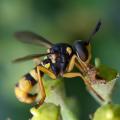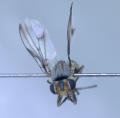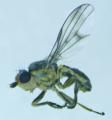Diptera.info :: Identification queries :: Diptera (adults)
Who is here? 1 guest(s)
|
Midge
|
|
| Marion Friedrich |
Posted on 07-06-2015 19:07
|
|
Member Location: Saxony, Germany Posts: 1151 Joined: 07.10.09 |
Hello, I did not find it in the Chaoboridae and Chironomidae album. Is ID possible? Thanks, Marion Marion Friedrich attached the following image:  [119.22Kb] Edited by Marion Friedrich on 09-06-2015 19:22 |
| Tony Irwin |
Posted on 07-06-2015 20:21
|
|
Member Location: Norwich, England Posts: 7232 Joined: 19.11.04 |
Tanypodinae, possibly Thienemannimyia
Tony ---------- Tony Irwin |
|
|
|
| John Carr |
Posted on 07-06-2015 23:56
|
|
Member Location: Massachusetts, USA Posts: 10172 Joined: 22.10.10 |
Similar to this fly: http://www.dipter...d_id=54237 I posted some of Fittkau's descriptions of species in that thread. |
| Marion Friedrich |
Posted on 08-06-2015 14:15
|
|
Member Location: Saxony, Germany Posts: 1151 Joined: 07.10.09 |
Many thanks for ID of the midge. The description fits well. Best wishes, Marion |
| mspies |
Posted on 09-06-2015 13:17
|
|
Member Location: Posts: 6 Joined: 04.09.13 |
Dear Marion et al., Sorry but no, the midge in your photo isn't even close to the description of Th. woodi (Edwards), the most obvious difference being that the latter species does not show any distinct wing pattern. Although it is rarely possible to identify chironomids from single, total-view photos - very often not even to the genus - my (somewhat educated) guess in your case is Rheopelopia maculipennis (Zetterstedt). If I am right, then the pictured male should have a noticeable brush or tuft of setae on the tip of mid tarsomere 3. Another part of the animal that would be important to check but isn't evaluable from your photo are the external genitalia. Incidentally, as can be seen in the Fauna Europaea database (http://www.faunae...), Rh. maculipennis is well known from Germany, whereas Th. woodi has never been recorded from this country. Regards, Martin Spies SNSB - Zoologische Staatssammlung Muenchen |
|
|
|
| Marion Friedrich |
Posted on 09-06-2015 19:28
|
|
Member Location: Saxony, Germany Posts: 1151 Joined: 07.10.09 |
Dear Martin, thanks for correction. Usually I check whether an insect is listed in Fauna Europaea, but in this case I didn´t. Only for my understanding, does distinct wing pattern mean that the pattern must be caused by the bulk of the wing and not only by the different color of the hairs? Here are two other pictures. Maybe they can help for ID. Regards, Marion Marion Friedrich attached the following image:  [113.76Kb] |
| Marion Friedrich |
Posted on 09-06-2015 19:29
|
|
Member Location: Saxony, Germany Posts: 1151 Joined: 07.10.09 |
2nd picture
Marion Friedrich attached the following image:  [164.96Kb] |
| mspies |
Posted on 13-06-2015 11:24
|
|
Member Location: Posts: 6 Joined: 04.09.13 |
Dear Marion, Your additional photos reveal a little more, but their resolution and focus aren't high enough to allow conclusive evaluation. For example, the gonostylus in the second image fits Rh. maculipennis, but other parts of the hypopygium are out of focus; similarly in the third image, the apex of mid tarsomere 3 looks like there may be an apical 'brush' indeed, but ... I hope you don't mind me saying so, but I think that you shouldn't rely on photos posted online and the comments you receive on them from people whose expertise you do not know enough to rely on it. Forums like this one here can offer pointers, but these cannot substitute for the unavoidable hard science to be done by every worker himself or herself. In the present case, I suggest you take a standard guide to species identifications such as Langton & Pinder (2007) - please see http://literature...ronomidae/x - and work through its relevant keys and illustrations (e.g., fig. 17D). Concerning your question about 'distinct wing patterns': In Chironomidae there are various different kinds of microscopic structures that can result in macroscopic appearance of colour or light-versus-dark patterns. Examples of such structures are dark setae sitting on the wing that can be rubbed off so that the pattern disappears, pigmentation on the wing membrane that doesn't rub off, and some others. However, my use of the word 'distinct' did not imply any of these morphological details, but simply meant that the wing pattern in your first image is obvious rather than faint or the like. Signing off from this thread with kind regards, Martin Spies Edited by mspies on 13-06-2015 11:27 |
|
|
|
| Marion Friedrich |
Posted on 13-06-2015 23:13
|
|
Member Location: Saxony, Germany Posts: 1151 Joined: 07.10.09 |
Dear Martin, Thanks for the detailed answer with the link to the Chironomidae database and for your patience. With best regards, Marion |
| Jump to Forum: |
















